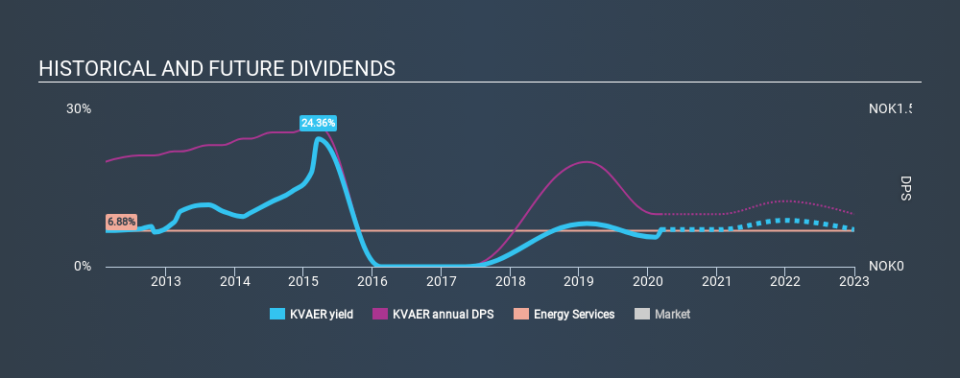Key Things To Watch Out For If You Are After Kværner ASA's (OB:KVAER) 7.1% Dividend

Today we'll take a closer look at Kværner ASA (OB:KVAER) from a dividend investor's perspective. Owning a strong business and reinvesting the dividends is widely seen as an attractive way of growing your wealth. Yet sometimes, investors buy a popular dividend stock because of its yield, and then lose money if the company's dividend doesn't live up to expectations.
With a goodly-sized dividend yield despite a relatively short payment history, investors might be wondering if Kværner is a new dividend aristocrat in the making. We'd agree the yield does look enticing. The company also bought back stock equivalent to around 0.9% of market capitalisation this year. Remember though, given the recent drop in its share price, Kværner's yield will look higher, even though the market may now be expecting a decline in its long-term prospects. Some simple research can reduce the risk of buying Kværner for its dividend - read on to learn more.
Click the interactive chart for our full dividend analysis
Payout ratios
Dividends are typically paid from company earnings. If a company pays more in dividends than it earned, then the dividend might become unsustainable - hardly an ideal situation. So we need to form a view on if a company's dividend is sustainable, relative to its net profit after tax. Looking at the data, we can see that 55% of Kværner's profits were paid out as dividends in the last 12 months. This is a fairly normal payout ratio among most businesses. It allows a higher dividend to be paid to shareholders, but does limit the capital retained in the business - which could be good or bad.
Another important check we do is to see if the free cash flow generated is sufficient to pay the dividend. Last year, Kværner paid a dividend while reporting negative free cash flow. While there may be an explanation, we think this behaviour is generally not sustainable.
While the above analysis focuses on dividends relative to a company's earnings, we do note Kværner's strong net cash position, which will let it pay larger dividends for a time, should it choose.
Remember, you can always get a snapshot of Kværner's latest financial position, by checking our visualisation of its financial health.
Dividend Volatility
One of the major risks of relying on dividend income, is the potential for a company to struggle financially and cut its dividend. Not only is your income cut, but the value of your investment declines as well - nasty. Looking at the last decade of data, we can see that Kværner paid its first dividend at least eight years ago. It's good to see that Kværner has been paying a dividend for a number of years. However, the dividend has been cut at least once in the past, and we're concerned that what has been cut once, could be cut again. During the past eight-year period, the first annual payment was kr1.00 in 2012, compared to kr0.50 last year. This works out to be a decline of approximately 8.3% per year over that time. Kværner's dividend hasn't shrunk linearly at 8.3% per annum, but the CAGR is a useful estimate of the historical rate of change.
A shrinking dividend over a eight-year period is not ideal, and we'd be concerned about investing in a dividend stock that lacks a solid record of growing dividends per share.
Dividend Growth Potential
With a relatively unstable dividend, and a poor history of shrinking dividends, it's even more important to see if EPS are growing. It's good to see Kværner has been growing its earnings per share at 55% a year over the past five years. With recent, rapid earnings per share growth and a payout ratio of 55%, this business looks like an interesting prospect if earnings are reinvested effectively.
Conclusion
When we look at a dividend stock, we need to form a judgement on whether the dividend will grow, if the company is able to maintain it in a wide range of economic circumstances, and if the dividend payout is sustainable. First, the company has a payout ratio that was within an average range for most dividend stocks, but it paid out virtually all of its generated cash flow. Next, earnings growth has been good, but unfortunately the dividend has been cut at least once in the past. Ultimately, Kværner comes up short on our dividend analysis. It's not that we think it is a bad company - just that there are likely more appealing dividend prospects out there on this analysis.
It's important to note that companies having a consistent dividend policy will generate greater investor confidence than those having an erratic one. However, there are other things to consider for investors when analysing stock performance. Case in point: We've spotted 5 warning signs for Kværner (of which 2 are a bit concerning!) you should know about.
Looking for more high-yielding dividend ideas? Try our curated list of dividend stocks with a yield above 3%.
If you spot an error that warrants correction, please contact the editor at editorial-team@simplywallst.com. This article by Simply Wall St is general in nature. It does not constitute a recommendation to buy or sell any stock, and does not take account of your objectives, or your financial situation. Simply Wall St has no position in the stocks mentioned.
We aim to bring you long-term focused research analysis driven by fundamental data. Note that our analysis may not factor in the latest price-sensitive company announcements or qualitative material. Thank you for reading.

